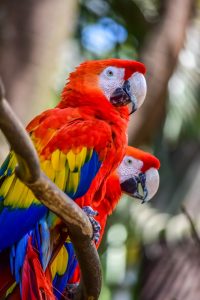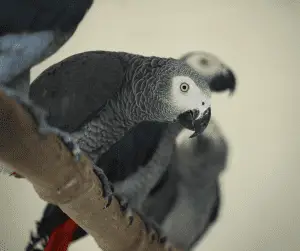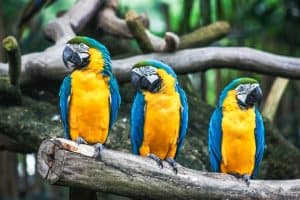Do birds know their names? Birds are fascinating creatures. They can fly, they can sing, and they can build nests. But do you know that birds can also talk to each other? And no, we’re not just talking about the chirping of a few sparrows. Bird language is a real phenomenon, and it’s something that anyone can learn! In this blog post, we will explore the fascinating world of bird language and discuss how you too can start communicating with our feathered friends.
The Study of Bird Language
In order to study whether birds know their own names, scientists started by teaching budgerigars—a type of small parakeet—to pick out a specific shape when presented with an array of different options. Once the budgerigars had mastered this task, they were then taught to associate their chosen shape with a particular sound. After completing this step, the researchers played a recording of each budgerigar’s individualized sound for them and observed their reaction.
Interestingly, the budgerigars tended to react more strongly—by moving their heads, perching on one leg, or even whistling—when they heard their own sound as opposed to the sounds of other budgerigars in the experiment. This led the scientists to believe that the budgerigars could indeed recognize their own names.
Birds and Communication
While the study’s findings are certainly intriguing, it’s important to keep in mind that they are by no means conclusive. Additionally, it’s worth noting that even if birds do know their own names, that doesn’t necessarily mean they understand the meaning of those words in the way that humans do. Still, the study provides an interesting glimpse into the fascinating world of bird communication.
How do birds communicate with each other?
Birds communicate with each other using a variety of sounds, body language, and visual cues. Many bird species, such as parrots and songbirds, use vocalizations to communicate. They produce a wide range of sounds, from simple chirps and clicks to more complex songs.
In addition to vocalizations, birds also use body language to communicate. They may spread their wings, raise their tail feathers, or bob their heads to convey a variety of messages.
Finally, birds also use visual cues to communicate. They may flick their tails, flash their brightly colored plumage, or engage in courtship displays to attract mates and establish dominance. By using a combination of these methods, birds are able to effectively communicate with each other in a wide range of situations.
The parrot family

Parrots are particularly well-known for their vocal abilities, which they use to great effect in both wild and captive settings. In the wild, parrots use their calls to communicate with each other about everything from food sources to predators. They also use their calls to keep track of flock mates who may be spread out over a large area.
In captivity, parrots often learn to mimic the sounds of human speech. This ability has made them popular pets, as many people enjoy being able to have conversations with their feathered friends. However, it’s important to remember that just because a parrot can mimic human speech does not mean that it understands the meaning of the words it is saying.
Can you communicate with pet birds?
While we may not be able to have full-fledged conversations with birds like Alex the African grey parrot, there are still ways to communicate with them. For example, many bird owners find that they are able to bond with their feathered friends by engaging in simple activities such as talking, singing, or even dancing together.
In addition, many bird species are able to learn a limited number of words and phrases. While this doesn’t allow for two-way conversations, it can still be a fun way to interact with your pet bird. If you’re interested in teaching your bird to talk, there are a number of resources available that can help you get started.
What is the most intelligent bird?

While there is no definitive answer to this question, the African grey parrots are often considered to be one of the most intelligent bird species. Other contenders for the title include crows, ravens, and magpies. These birds are all known for their ability to solve complex problems and use tools in creative ways.
Young birds and communication
While most birds learn to communicate through trial and error, young birds often receive help from their parents and other members of their flock. For example, young songbirds must learn the complex songs of their species in order to attract mates and establish territories. They typically do this by listening to and imitating the adults around them.
Baby parrots, on the other hand, are born with the ability to mimic sounds. However, they must still learn how to use these sounds in order to communicate effectively with other members of their species. They typically do this by observing and copying the surrounding adults.
Birds respond best to positive reinforcement

Whether you’re trying to teach your pet bird to talk or just want to bond with it, it’s important to use positive reinforcement. This means rewarding your bird for good behavior with treats, praise, or attention.
Birds are intelligent creatures that are capable of complex social interactions. By taking the time to learn about bird language, you can deepen your understanding of these fascinating creatures. Who knows, you might even be able to have a conversation with your feathered friend one day!
So, Do birds know their names?
Do Birds Know Their Names? The jury is still out on whether birds know their own names, but recent studies suggest that some birds may be able to recognize and respond to the sound of their name. While more research is needed to confirm these findings, they provide an interesting glimpse into the fascinating world of bird communication.
Bird Names for Cockatiels: Over 50 Ideas for Your New Pet
- Do Cockatiel Bites Hurt Are They Dangerous
- Do Cockatiels Cry
- Do Cockatiels Dance
- Do Cockatiels Eat Insects
- Do Cockatiels Get Lonely
- Do Cockatiels Like Music
- Do Cockatiels Like The Dark
- Do Cockatiels Like To Cuddle
- Do Cockatiels Mate For Life
- Do Cockatiels Need A Companion
- Do Cockatiels Need Cuttlebone
- Do Cockatiels Need Darkness To Sleep
- Do Cockatiels Need Grit
- Do Cockatiels Recognize Their Owners
- Do Cockatiels Sneeze
- Do Conures And Cockatiels Get Along
- Do Birds Know Their Names



